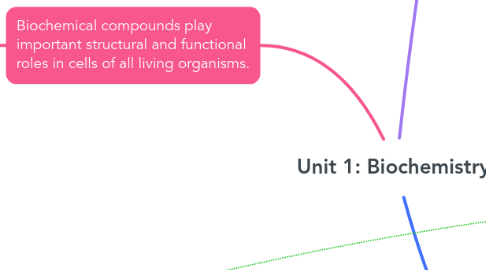
1. Biochemical compounds play important structural and functional roles in cells of all living organisms.
1.1. Carbohydrates
1.1.1. Preferred energy source + structural support
1.1.2. Simple sugars: monosaccharides + disaccharides
1.1.2.1. Monosaccharides: (CH2O)n formula with a ratio of 1C:2H:1O. Will have 3,5, or 6 carbons, called triose, pentose, or hexose. They are linear, but 5+ carbons will result in a ring structure in water (due to reaction between 2 functional groups)
1.1.2.2. Disaccharides: 2 monosaccharides joined together by dehydration synthesis, resulting in a glycosidic bond.
1.1.3. Complex carbohydrates
1.1.3.1. Polysaccharides
1.1.3.1.1. Many monosaccharides linked by glycosidic bonds. Through polymerization, other biological compounds are made (DNA, protein, etc...)
1.1.3.1.2. Polar (thus hydrophilic), is able to do hydrogen bonding, insoluble in water
1.2. Lipids
1.2.1. The major component of cell membrane + energy source
1.2.1.1. Phospholipids
1.2.1.1.1. 2 fatty acids + phosphate group + glycerol. Has both a polar and non-polar end (a.k.a amphipathic molecule). Glycerol can bond 3 times but 1/3 times in phospholipids is bonded to a phosphate group instead of a fatty acid.
1.2.1.2. Steriods
1.2.1.2.1. 4 carbon rings and is amphipathic
1.2.1.3. Waxes
1.2.1.3.1. Large lipid molecules with long fatty acid chains linked to alcohol/carbon rings
1.2.1.4. Triglycerides
1.2.1.4.1. 3 fatty acid chains + glycerol
1.2.2. Composed of fatty acids (carboxyl functional group + single hydrocarbon chain)
1.2.2.1. Fatty acid is acidic due to the presence of the carboxyl functional group. The longer the fatty aid, the more hydrophobic (less water-soluble)
1.2.2.2. Saturated + unsaturated fatty acids
1.2.2.2.1. Saturated: linear chain with only single bonds between carbons. The max # of hydrogen atoms possible is bonded with each carbon
1.2.2.2.2. Unsaturated: non-linear, with at least one double/triple bond between carbons. There are less hydrogen atoms than what is possible
1.3. Proteins
1.3.1. Structural support, enzymes help reactions happen, and helps with transport within the cell
1.3.2. Composed of amino acid monomers. Amino group + carboxyl group + a hydrogen atom bound to a central carbon atom + R group.
1.3.2.1. Peptide bonds: amino acid monomer chains connected by peptide bonds. Peptides with 50+ amino acids are called polypeptides.
1.3.2.2. Sequence of amino acids determine shape and function
1.3.2.2.1. Denaturation: environmental changes (temp/pH, etc...) changes protein shape, so it no longer functions, it reforms, or organism dies.
1.3.3. 4 structure groups: primary, secondary, tertiary, and quaternary
1.3.3.1. Primary: beads on a string, amino acids joined by peptide bonds
1.3.3.2. Secondary: hydrogen boning between O,H,N atoms of peptide backbone. Alpha helix and b pleated sheet shapes.
1.3.3.3. Tertiary: hydrogen bonds between "R" polar amino acids, is a combination of helices and sheets
1.3.3.4. Quaternary: 1+ polypeptides associating together. There is also a disulfide bridge (2 cysteine amino acids + sulfur R goups bond)
1.4. Nucleic Acids
1.4.1. Composed of nucleotides (phosphate + deoxyribose sugar + nitrogenous base).
1.4.1.1. DNA and RNA are nucleic acids (more: rRNA, tRNA, mRNA)
2. Technological applications that affect biological processes and cellular functions are used in the food, pharmaceutical, and medical industries.
2.1. Enzymes
2.1.1. 3d protein molecules that speed up chemical reactions (a.k.a. a catalyst). They lower the activation energy so that the reaction happens more easily. The enzyme binds with a substrate at the active site to start reaction. If the shapes are different, the reaction will not happen (specific enzymes have specific shape of substrate as each one has a different purpose.
2.1.1.1. They have optimal ranges, so if temperature and pH does not reach optimal range or goes over, it will denature.
2.1.1.2. Speeds up reactions in pharmaceuticals, baking, digestion, etc... This also lowers factors such as cost, material usage and increases efficiency and meets demands.
2.1.1.2.1. Baking bread: the enzyme maltase breaks down maltose into glucose . Then, other enzymes in the yeast will react to create CO2, causing bread to rise.
2.1.1.2.2. Digestion: speed up reactions in digestion. Saliva also has enzymes that help with starch absorption/digestion.
2.1.1.2.3. Pharmaceuticals: speeds up the reactions in which medicine is made
2.2. Pharmacogenomics: drugs that are made to cater to one's unique genetic makeup.
2.2.1. Scientists look at genetic makeup and how the DNA reacts to each drug.
2.2.1.1. If there are many receptors to the drug, then there is a strong response. If there are no receptors or the receptors are of different shape compared to the drug, then there is no response to the drug.
3. Biological molecules and their chemical properties affect cellular processes and biochemical reactions.
3.1. ATP
3.1.1. Energy for living things. Can be made from photosynthesis and cellular respiration.
3.2. Functional groups + properties
3.2.1. https://www.chemistryhelpcenter.org/wp-content/uploads/2018/01/Functional-groups-1024x615.png
3.3. Enzymes
3.3.1. Speeds up reactions by decreasing activation energy.
3.4. Polarity: polar covalent bonds vs non-polar covalent bonds
3.4.1. Polar covalent: electronegative difference is greater than 0.5 and less than 2.0 (for ionic bonds), bond is considered polar
3.4.1.1. Polar = hydrophilic. Can mix with water.
3.4.2. Non-polar covalent: electronegative difference is less than 0.5, bond is non-polar
3.4.2.1. Non-polar = hydrophobic. Cannot mix with water.
3.4.3. Polarity is important in cellular processes as it decides whether reactions happen or not, the orientation with other molecules, bond attraction with other molecules, and more. Overall, it is important in the cell's function and development.
